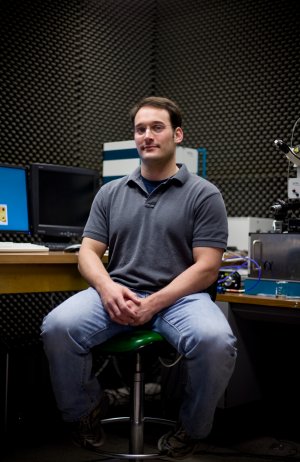May 7 2010
Gold isn't exactly what comes to mind when you think of treatments for cancer. But researchers at Ohio University are exploring whether the metallic element can actually save lives.
Michael Carlson, a third-year doctoral student in chemistry and biochemistry at Ohio University, is studying how small particles of gold, heated by a laser, can kill malignant cancer cells.
 Photo by: Erica McKeehen
Photo by: Erica McKeehen
In 2005, researchers from the University of Southern California and the Georgia Institute of Technology discovered that nanoparticles (tinier than the diameter of a human red blood cell) of gold can attach themselves to cancer cells and absorb enough heat to destroy them. The particles also made it easier for doctors to identify tumors on the computer screens used to navigate surgeries in the operating room, which, in turn, helped the surgeons to attack and remove the cancerous tissue.
Carlson and his advisor, Professor of Chemistry and Biochemistry Hugh Richardson, are conducting further studies to learn more about the process of how these relatively non-toxic gold particles combat the tumors. They hope to compile more data in order to help develop and refine the technology for medical treatments.
“Current treatments such as chemotherapy and radiation are pretty invasive procedures that harm the sick patient,” Carlson explained. “The ultimate goal would be to successfully use gold nanoparticles to non-invasively destroy the tumor.”
Richardson and his colleagues have been studying the heating of gold nanoparticles at Ohio University since 2005. He has published more than 11 scientific articles about the chemical reactions in metal nanoparticles.
In the new studies, Carlson and Richardson examine the heat generated by the nanoparticles as they absorb the light energy of the laser. This will help other researchers determine what happens to the cancer cells before they are killed.
“It is obvious that the cells are becoming hot, but we want to know if the energy simply dissipates from the cell, if the cell melts, or if a bubble forms inside the cell where the cell then explodes,” Carlson said. “Or it may be something completely different.”
So far, the scientists have found that the laser allows the gold particles to reach a heat that is ten times hotter than the boiling point of water. Carlson's research also suggests that the gold nanostructures' change in temperature reaches a threshold, despite the amount of energy applied to the particles, which is indicative of possible micro-bubble formation.
Originally interested in becoming a doctor, Carlson was attracted to cancer research because of its ability to help large numbers of people.
“If you can create a way to help people rather than a single individual, like developing a mechanism that is applicable to all cancer patients, you are doing a great thing,” he said.